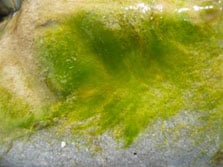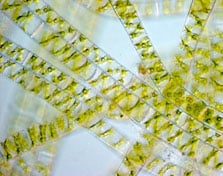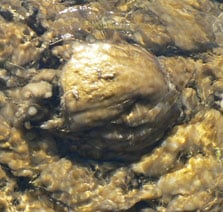Introduction
Green slime and brown scum on stream beds is usually regarded as an unattractive nuisance however, it is a vital part of stream ecosystems.
Spirogyra
What are algae?
Algae are simple, aquatic, plant-like organisms that do not have true roots, stems and leaves. Many are single-celled so can only be seen using a microscope, while others grow in filaments or mats that are quite conspicuous. Algae have chlorophyll and can make their own food through the process of photosynthesis.
Although algal growths can often be seen in the water, a microscope is required to appreciate their beauty and complexity.

Spirogyra under a microscope
Why are algae important?
- Algae produce oxygen as a waste product of photosynthesis. Cyanobacteria are amongst the most ancient forms of life and they have been contributing oxygen to the world’s atmosphere for the last three billion years.
- Cyanobacteria are able to fix nitrogen from the atmosphere. All organisms require large amounts of nitrogen for their metabolism and cyanobacteria play an important role in making atmospheric nitrogen available in nutrient cycles.
- Algae help to ‘purify’ water by absorbing nutrients and heavy metals from streams and rivers.
- Algae are the basis of most aquatic food webs. They are food for many small aquatic invertebrates, and in turn, these small creatures are food for larger animals such as fish. Algae also provide important habitats for invertebrates and fish. Without organisms that can capture energy from the sun by photosynthesis, none of the higher organisms would exist.
- Algae can be valuable indicators of environmental quality. Many are sensitive to changes in pH, in nutrient levels or in temperature. Monitoring species abundance and composition can be useful to identify changes in water quality caused by changes in surrounding land use.
Where are algae found?
Freshwater algae are found growing underwater on rocks and mud in streams and rivers. They are usually more abundant in slower streams than in fast flowing rivers. Didymo, the exotic pest alga commonly known as ‘rock snot’, is one of the few species that grow well in swift rivers. However, even didymo cannot withstand turbulent flood waters.

Gomphoneis
What types of freshwater algae are there?
The main groups of algae found in streams are the green algae (Chlorophyta), red algae (Rhodophyta), blue-green algae (Cyanobacteria) and diatoms (Bacillariophyta).
Green algae: Green algae often look like strands of green hair flowing in the current. Spirogyra is a common green alga. Under a microscope its chloroplasts are clearly seen as spirals.
Red algae: Red algae, such as Audouinella, uses a different part of the light spectrum it is able to grow in places where the other algae can’t, so tends to be found in shaded places such as under rocks or banks.
Blue-green algae: The chlorophyll in the alga Cyanobacteria is not in chloroplasts but diffused throughout the cell. Pigments, other than chlorophyll, contribute to their colouration so cyanobacteria are not usually bright green. Nostoc is another cyanobacteria that is often conspicuous in streams. It looks like bubbles of firm jelly attached to the rocks. The ‘bubbles’ are masses of small chains of cells. .

Didymo
Diatoms: Mats of brown growth, fluffy masses or slimy layers on rocks are some of the ways diatoms appear to the naked eye. Gomphoneis forms thick, glistening, light-brownish mats on river substances and is often mistaken for didymo. However, didymo has much larger cells and grows in tougher, more fibrous mats.
Can algae be bad?
- Excessive nutrients in runoff from land used for intensive agriculture will alter the natural composition of algae in streams and rivers. If the natural balance is disturbed algal blooms may occur, causing undesirable discolouration, scum and odours and even toxic effects.
- Didymo (Didymosphenia geminata) is an example of an introduced organism that has grown into unsightly mats over stream and river bottoms. In many places it has out-competed the native algae and destroyed invertebrate and fish habitat. Be fastidious in taking measures to stop the spread of didymo. Follow the simple rules – Check, Clean, Dry – when moving from one waterway to another.